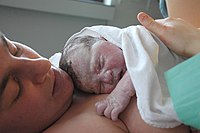
Photo from wikipedia
BACKGROUND Ultrasound offers objective and reproducible methods to measure fetal head station. Before these methods can be applied to assess labor progress, fetal head descent needs to be evaluated longitudinally… Click to show full abstract
BACKGROUND Ultrasound offers objective and reproducible methods to measure fetal head station. Before these methods can be applied to assess labor progress, fetal head descent needs to be evaluated longitudinally in well-defined populations and compared to existing data derived from clinical examinations. OBJECTIVE We aimed to use ultrasound measurements to describe fetal head descent longitudinally as labor progressed through the active phase in nulliparous women with spontaneous onset of labor. STUDY DESIGN This was a single center, prospective cohort study at Landspitali University Hospital, Reykjavik, Iceland, from January 2016 to April 2018. Nulliparous women with a single fetus in cephalic presentation, spontaneous labor onset at gestational age ≥37 weeks were eligible. Inclusion occurred on admission for women with an established active phase of labor or at the start of the active phase in women admitted in the latent phase. Active phase was defined as an effaced cervix dilated at least four cm in women with regular contractions. According to clinical protocol vaginal examinations were done at entry and subsequently through labor, paired each time with a transperineal ultrasound examination by a separate examiner, both examiners being blinded to the other´s results. Measurements used to assess fetal head station were head-perineum distance and angle of progression. Cervical dilatation was examined clinically. RESULTS The study population comprised 99 women. Labor patterns for head-perineum distance, angle of progression and cervical dilatation differentiated into 75 spontaneous, 16 instrumental vaginal and eight cesarean deliveries are presented in the figure. At inclusion cervix was dilated four cm in 26, five cm in 30 and ≥ six cm in 43 women. One cesarean and one ventouse delivery were performed for fetal distress, the remaining due to failure to progress. The total number of examinations was 345, on average 3.6 per woman. Ultrasound measured station both at the first and last examination were associated with delivery mode and remaining time in labor. In spontaneous deliveries rapid head descent started around four hours before birth, the descent being more gradual in instrumental deliveries and absent in cesarean deliveries (Figure). Head-perineum distance of 30 mm and angle of progression of 125° separately predicted delivery in 3.0 hours (95% CI for 2.5-3.8 hours and 2.4-3.7 hours respectively) in women delivering vaginally. Head-perineum distance and angle of progression are independent methods, but gave similar mirror image patterns. The fetal head station at the first examination was highest for fetuses in occiput posterior position, but the pattern of rapid descent was similar for all initial positions in spontaneously delivering women. Oxytocin augmentation was used in 41% of women; in these labors slower descent was noted. Descent was only slightly slower in the 62% of women with epidural analgesia. A non-linear relationship was observed between station and dilatation. CONCLUSIONS We have created ultrasound measured descent patterns for nulliparous women in spontaneous labor. The patterns resemble previously published patterns based on clinical vaginal examination. Ultrasound measured station was associated with delivery mode and remaining time in labor.
Journal Title: American journal of obstetrics and gynecology
Year Published: 2020
Link to full text (if available)
Share on Social Media: Sign Up to like & get
recommendations!